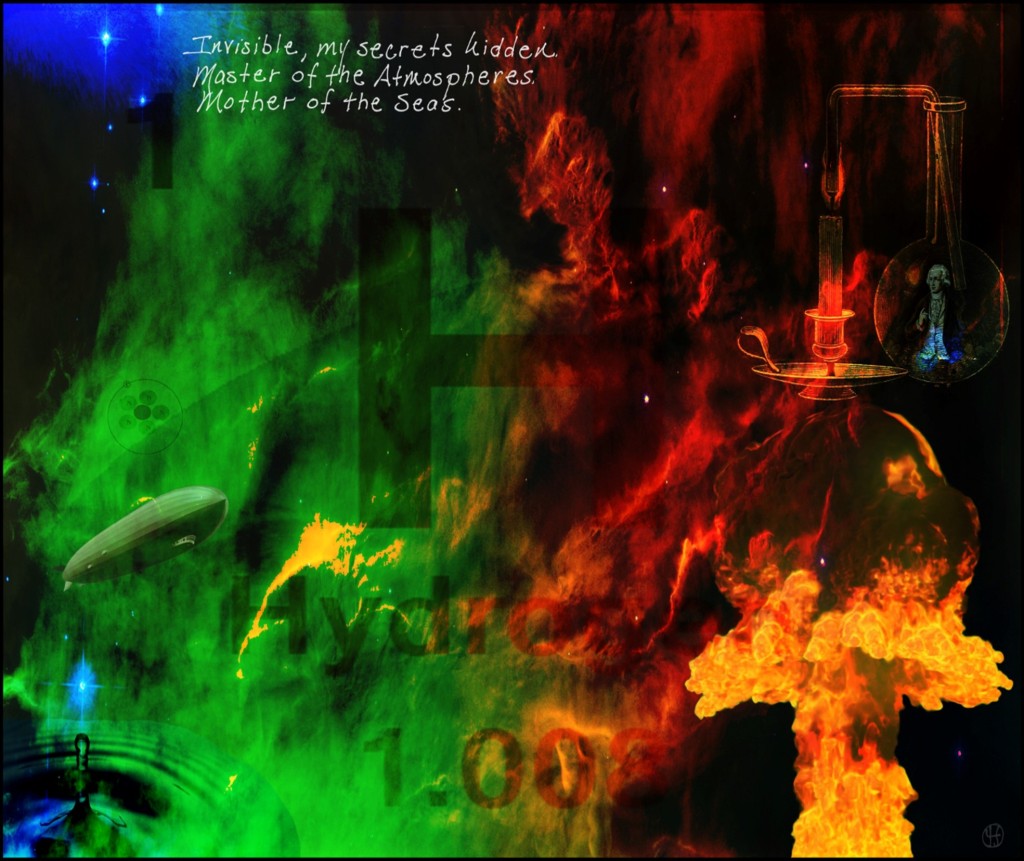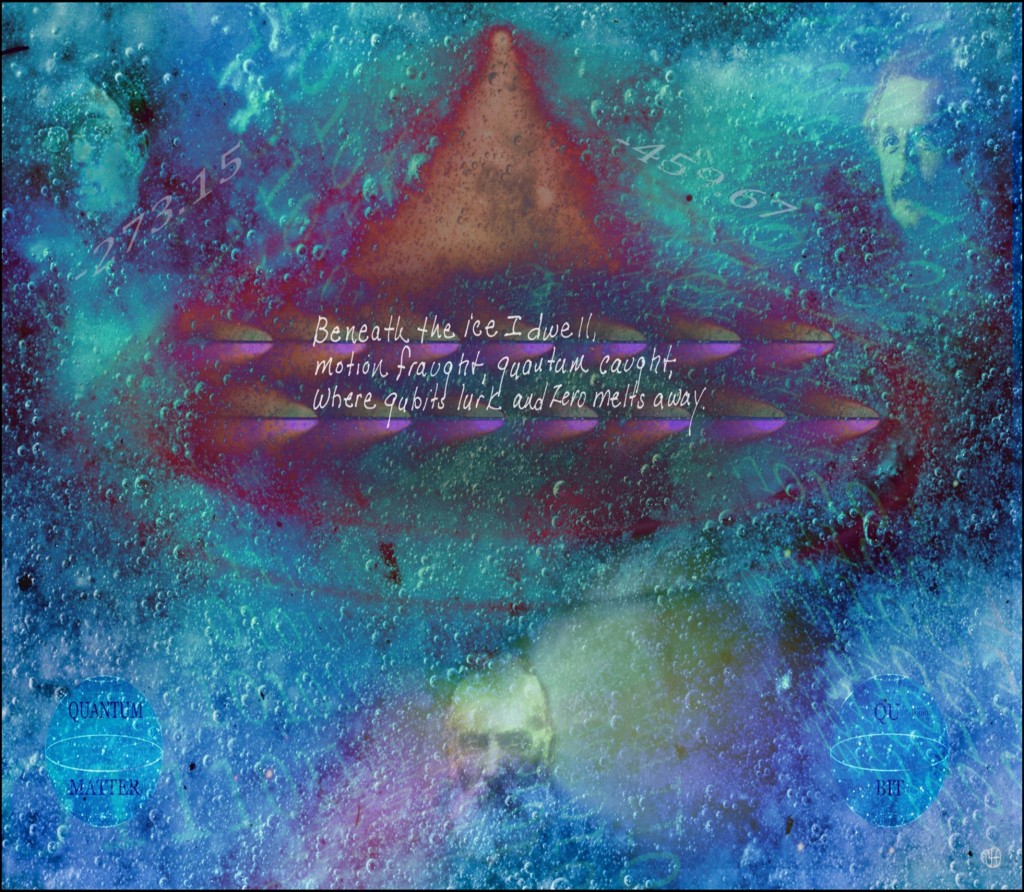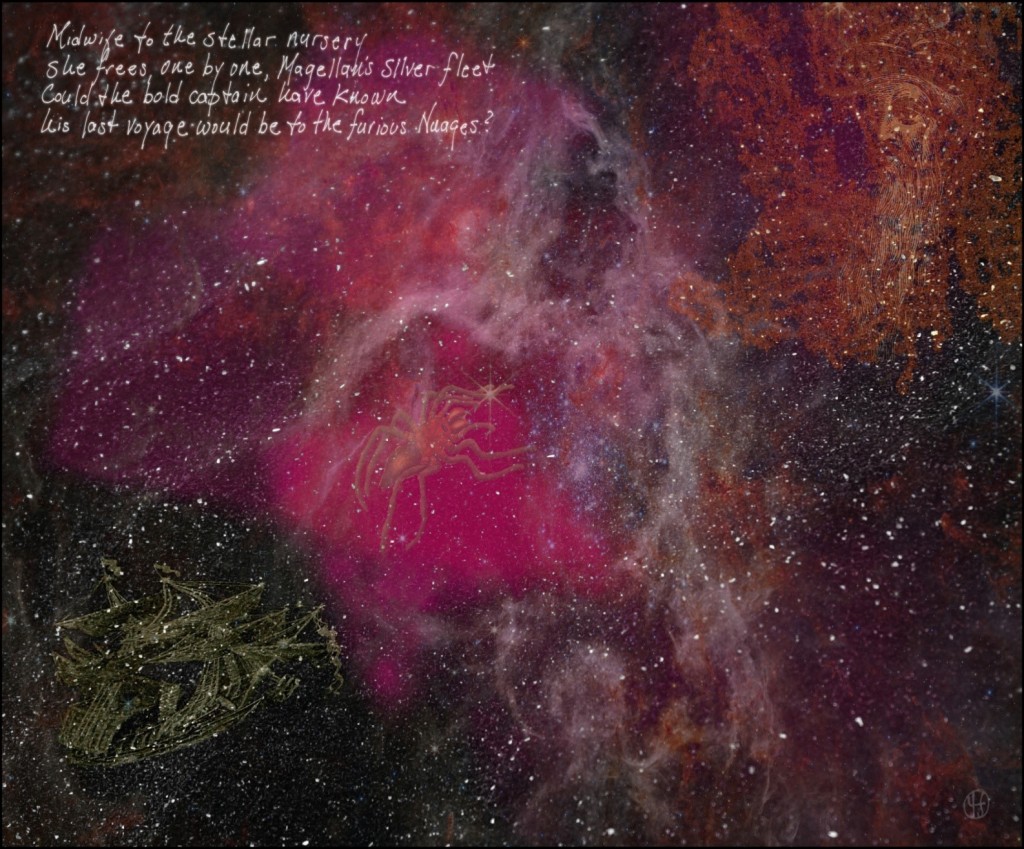1. “Hydrogen”

2. “Absolute Zero”

3. “Tarantula Nebula”

VISUAL POETRY DESCRIPTIONS
1.
Invisible, my secrets hidden,
Master of the Atmospheres,
Mother of the Seas.
Design Elements in the Visual Poem: “Hydrogen.”
The design elements in this visual poem reference hydrogen, the first element in the periodic table and the most pervasive element in the universe. Underlying all the graphic elements are two aspects of hydrogen, the element’s visible spectrum and the periodic table listing for Hydrogen, including its atomic weight and number, seen against the background of the gas-rich Lagoon Nebula. To the right English scientist Henry Cavendish is seen within a candle distillation apparatus, an 18th century instrument suggestive of the device Cavendish used to study the chemistry of gasses. Cavendish first recognized hydrogen as an element and called it “flammable air.” Below Cavendish is a hydrogen bomb explosion, one of the element’s “secrets” alluded to in the poem. To the left is the symbol for Hydrogen6 (6H) atom with 1 proton and 5 unbounded neutrons. This atom decays over time to produce the element deuterium. Below Hydrogen6, the hydrogen fueled and ill fated Graf Zeppelin, and, below that, a water droplet representing the essential role hydrogen plays in sustaining life on this and, likely, other planets.
Sources:
1911 Encyclopedia Britannica: “Henry Cavendish”
Live Science: “Hydrogen Facts”
Fact File: “57 Important Hydrogen Facts You Should Know.”
Periodic Table of Elements (fandom.com): “Hydrogen 6”
Note: Al base images are in the public domain.
2.
Beneath the ice I dwell,
motion fraught, quantum (Kelvin) caught,
where qubits lurk and zero fades away.
Design elements in the Visual Poem: “Absolute Zero”
Three famous scientists played essential roles in the discovery of “Absolute” Zero” and its applications. In the nineteenth century, physicist William Thomson, better known as Lord Kelvin, developed the “Kelvin scale” designating “zero” as “0” measured as -273.15 C or -459.67 F. These numbers appear in this visual poem beneath the images of physicist Satyendra Nath Bose, to the left, and Albert Einstein to the right. Bose and Einstein played a critical role in our understanding of ultra cold environments in their formulation of the Bose-Einstein Condensate, which describes the strange behavior of atomic particles as a quantum field of matter. Their descriptive theory, first formulated 1924 but not proven until 1995, paved the path for the scientific manipulation of atomic particles in absolute zero environments. This, in turn, opened the way to experiments in magnetism and the development of quantum computers. At the heart of quantum computing is the qubit, a basic unit of quantum information which forms a superimposition of bits and bytes, allowing it to hold more information.
Design elements in this visual poem bring together all these aspects of absolute zero. Underlying all is an ice field in which bits and bytes are imprisoned. The coldest known spot in the cosmos, the Boomerang Nebula, is also present just behind Lord Kelvin’s image. Quantum computing and qubits are referenced at lower left and right. Central to the image is the wavelike Bose-Einstein Condensate. The poem, at the center of the condensate, evokes the overall design even suggesting that in quantum computing “zero melts away.”
Sources:
NBC News Mach: “What is Absolute Zero?”
MIT News: “A Faster Way to Make Bose-Einstein Condensates.”
MIT News: “A Faster Way to Make Bose-Einstein Condensates.”
Smithsonian News Release: “One Atom to Rule Them All: A New Class of Quantum Matter Observed.”
Note: All base images are in the public domain.
3.
Midwife to the stellar nursery,
she frees, one by one, Magellan’s silver fleet.
Could the bold navigator have known
his last voyage would be to the furious Nuages?
Design elements in the Visual Poem: “Tarantula Nebula”
The Tarantula Nebula, a section the Large Magellenic Cloud, has rightfully been described as a nursery of stars, a turbulent area of the cosmos in which new stars are formed amidst a web of cosmic dust and debris.
The Magellenic Clouds have long been an area of astronomical mystery and speculation. Bearing the scientific name of “the Nubeculae” or “les Nuages”, they are a pair of dwarf galaxies slowly being absorbed into our own Milky Way. The more familiar title became popular after 17th century sailors named the galaxies in honor of famed Portuguese explorer, Ferdinand Magellan.
Since the Clouds were not used as a maritime navigational aid, they were remarked but little regarded by European sea captains during the Age of Exploration. The Clouds did catch the attention of indigenous people in South America, though, who carved the celestial marvels into stone.
One of those Chilean petroglyphs from the Valle del Encanto is graphically represented in this design as a golden, leaf-shaped artifact behind which peers an image of Magellan himself. The background image is a graphically-enhanced Hubble telescope rendering of the Tarantula Nebula within which we find the arachnid guardian of the nursery releasing a star. At bottom left a Portuguese carrack similar to that captained by Magellan, speeds toward a fateful encounter with the explorer’s “silver fleet” of stars.
On a side note, the newly operating Webb telescope has recently produced a stunning image of the famous nebula.
Sources:
Universe Today: “Wow. Here’s Webb’s View of the Tarantula Nebula.”
Universe Today: “A History of the Magellenic Clouds and How They Got Their Names.”
The Nine Planets: “Magellenic Cloud Facts.”
Note: All base images are in the public domain.
Born in an island archipelago, ithacan now resides somewhere north of El Paso. ithacan’s visual poetry has appeared most recently in Poemeleon.
